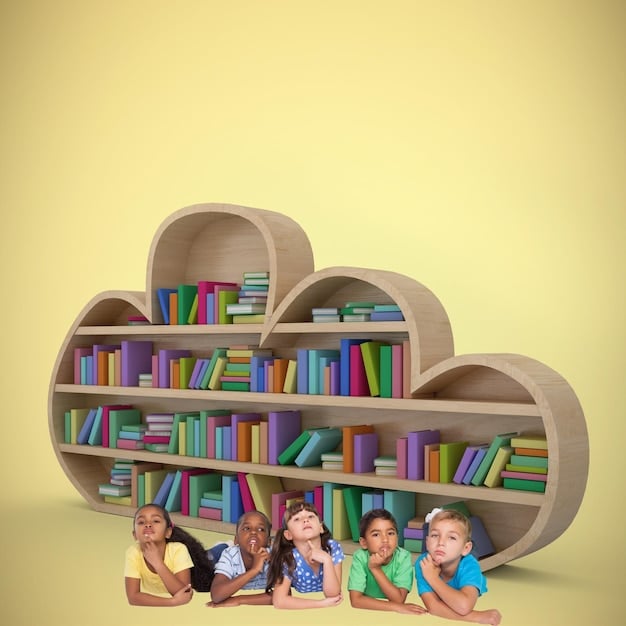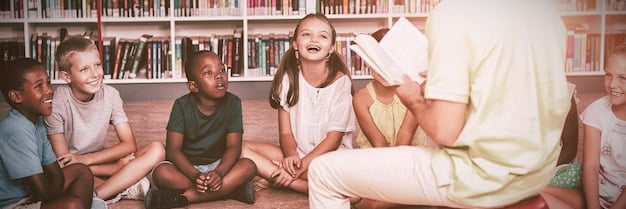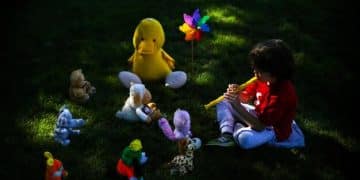Gift Guide 2025: Best Books to Encourage Kids Reading

Gift Guide 2025 offers a curated selection of the best books for kids of all ages, designed to ignite a lifelong love for reading through engaging stories and educational content.
Looking for the perfect gift to spark a child’s imagination and foster a love of reading? Our gift guide: the best books for kids of all ages to encourage reading in 2025 provides a curated selection of engaging and educational books that are sure to delight young readers.
Unlocking the World Through Reading: Why Books Matter
Reading is a gateway to knowledge, imagination, and personal growth. For children, books offer a chance to explore new worlds, learn about different cultures, and develop critical thinking skills. Encouraging reading from a young age can have profound and lasting benefits. But with so many options available, how do you choose the right books? This gift guide will help you navigate the world of children’s literature and find the perfect titles to inspire young readers in 2025.
The Importance of Early Literacy
Early literacy skills are foundational for academic success. Children who are exposed to books and reading at a young age tend to have larger vocabularies, better comprehension skills, and a greater overall understanding of the world around them. Making reading a fun and engaging activity can set them on the path to a lifelong love of learning.
Creating a Reading-Friendly Environment
It’s not just about the books themselves; it’s also about creating an environment that encourages reading. Make books accessible by placing them in visible and inviting locations around the house. Dedicate a special reading nook where children can relax and immerse themselves in their stories. And most importantly, lead by example by showing your own enjoyment of reading.
- Make reading a regular part of your daily routine.
- Visit the library together to discover new books.
- Discuss the stories and characters with your child.
- Encourage them to write their own stories and draw illustrations.
By fostering a love of reading, you’re giving children a gift that will benefit them for years to come. Books open doors to new possibilities, expand their horizons, and empower them to become lifelong learners.

Picture Books: Captivating the Youngest Readers
Picture books are an excellent way to introduce young children to the joy of reading. With their vibrant illustrations and simple stories, they can capture the imagination and spark a love of books from an early age. Choosing picture books that are age-appropriate and engaging is crucial for fostering a positive reading experience.
Picture books often incorporate repetitive language, predictable storylines, and memorable characters. These elements help children develop phonemic awareness, build vocabulary, and understand the basic concepts of storytelling. Reading aloud to children is a wonderful way to bond and create shared experiences around books.
Popular Picture Book Themes
Picture books cover a wide range of themes, from everyday experiences to fantastical adventures. Some popular themes include:
- Animals
- Friendship
- Family
- Bedtime
- Adventures
Tips for Choosing Picture Books
- Look for books with engaging illustrations that capture your child’s attention.
- Choose books with simple, easy-to-understand text.
- Consider books that feature diverse characters and cultures.
- Read reviews and recommendations from other parents and educators.
Picture books are more than just stories; they are tools for learning, growth, and connection. By carefully selecting picture books, you can help young children develop a lifelong love of reading and a thirst for knowledge.
Early Chapter Books: Bridging the Gap to Independent Reading
As children develop their reading skills, early chapter books provide a bridge between picture books and more complex novels. These books typically feature shorter chapters, simpler vocabulary, and engaging storylines that keep young readers motivated. Selecting the right early chapter books can help children build confidence and independence as readers.
Early chapter books often focus on themes that are relevant to young children’s lives, such as friendship, school, and family. They may also introduce elements of fantasy or adventure, sparking their imagination and encouraging them to explore new possibilities. The key is to find books that are challenging enough to promote growth, but not so difficult that they become frustrating.
What to Look for in Early Chapter Books
- Engaging characters that young readers can connect with
- Plots that are easy to follow and understand
- Manageable chapter lengths
- Illustrations that break up the text and provide visual cues
Popular Early Chapter Book Series
There are many popular early chapter book series that are perfect for introducing children to independent reading. Some examples include:
- “Junie B. Jones” by Barbara Park
- “Magic Tree House” by Mary Pope Osborne
- “Mercy Watson” by Kate DiCamillo
- “Flat Stanley” by Jeff Brown
Providing children with a variety of early chapter books can help them discover their reading preferences and develop a lifelong love of reading. It’s important to encourage them to choose books that interest them and to provide support as they navigate the challenges of independent reading.

Middle Grade Novels: Exploring Deeper Themes and Complex Characters
Middle grade novels are designed for children in grades 4-8 and typically explore more complex themes and characters. These books often deal with issues such as identity, friendship, family relationships, and navigating the challenges of adolescence. Middle grade novels can be a powerful tool for helping children develop empathy, critical thinking skills, and a deeper understanding of the world around them.
Middle grade novels often feature diverse perspectives and experiences, allowing readers to learn about different cultures, backgrounds, and points of view. They can also provide a safe space for children to explore difficult topics and grapple with complex emotions. Choosing middle grade novels that are age-appropriate and aligned with their interests is crucial for fostering a positive reading experience.
Exploring Different Genres in Middle Grade Fiction
Middle grade fiction encompasses a wide range of genres, including:
- Fantasy
- Science Fiction
- Historical Fiction
- Realistic Fiction
- Mystery
Tips for Selecting Middle Grade Novels
When choosing middle grade novels, consider the following tips:
- Read reviews and recommendations from other readers and educators.
- Consider books that feature diverse characters and perspectives.
- Choose books that align with your child’s interests and reading level.
- Discuss the themes and characters with your child after they finish reading.
Middle grade novels can be a powerful tool for helping children develop into thoughtful, empathetic, and engaged citizens. By providing them with access to a wide range of books, you can help them explore their own identities and navigate the complexities of the world around them.
Young Adult Literature: Engaging Teen Readers with Relevant Stories
Young adult (YA) literature is designed for teenagers and typically tackles issues that are relevant to their lives, such as identity, relationships, social justice, and personal growth. YA novels often feature complex characters, compelling plots, and thought-provoking themes that can resonate deeply with teen readers. Choosing YA literature that is engaging and meaningful can help teenagers develop a lifelong love of reading and a deeper understanding of themselves and the world around them.
YA literature often pushes boundaries and challenges conventional thinking, providing a space for teenagers to explore different perspectives and grapple with difficult questions. It can also offer a sense of community and connection for readers who may feel isolated or misunderstood. The key is to find books that are both entertaining and thought-provoking, encouraging teenagers to think critically and engage with the world around them in a meaningful way.
The Power of Relatable Characters
One of the key features of successful YA literature is relatable characters. Teenagers often connect with characters who are struggling with similar issues or facing similar challenges. This connection can provide a sense of validation and hope, reminding them that they are not alone in their experiences.
Exploring Contemporary Issues
YA literature often tackles contemporary issues such as:
- Mental health
- Social justice
- Identity
- Relationships
- Future prospects
By exploring these issues in a thoughtful and engaging way, YA literature can help teenagers develop empathy, critical thinking skills, and a deeper understanding of the world around them.
Beyond the Page: Fostering a Love of Reading Through Activities
Encouraging a love of reading goes beyond simply providing books. Engaging children in activities that complement their reading experiences can deepen their understanding, spark their imagination, and make reading even more enjoyable. These activities can range from simple crafts and discussions to more elaborate projects and events. The key is to find activities that are engaging, age-appropriate, and aligned with their interests.
Creating Book-Related Crafts
Crafting is a wonderful way to bring stories to life. Children can create artwork inspired by their favorite characters, build models of scenes from the books, or design costumes based on the characters’ attire. This hands-on approach can help them connect with the stories on a deeper level and express their creativity.
Book Clubs and Discussion Groups
Book clubs and discussion groups provide a space for children to share their thoughts and ideas about the books they are reading. These groups can foster critical thinking skills, encourage empathy, and provide a sense of community for young readers. Facilitators can guide the discussions by asking thought-provoking questions and encouraging different perspectives.
Bringing Stories to Life Through Performance
Performing scenes from books is another engaging way to foster a love of reading. Children can act out their favorite scenes, create puppet shows, or even write their own adaptations of the stories. This activity can help them develop their communication skills, build confidence, and deepen their understanding of the characters and plot.
By incorporating these activities into your reading routine, you can create a rich and rewarding experience for young readers. The goal is to make reading a fun and engaging activity that will foster a lifelong love of learning and a thirst for knowledge.
| Key Aspect | Brief Description |
|---|---|
| 📚 Early Literacy | Focuses on building foundational reading skills from a young age. |
| 🎨 Picture Books | Engage young readers with vibrant illustrations and simple stories. |
| ✅ Chapter Books | Bridge the gap to independent reading with manageable content. |
| 🌟 YA Literature | Engage Teen Readers with Relevant Stories that tackle contemporary issues. |
Frequently Asked Questions
▼
This guide covers books for kids of all ages, from toddlers to teenagers. Each section focuses on a specific age range and reading level, ensuring that you can find the perfect book for the child in your life.
▼
Consider the child’s reading ability, interests, and maturity level. Look for books with age-appropriate themes, vocabulary, and plot complexity. Reviews and recommendations from other parents and educators can also be helpful.
▼
Make reading a fun and engaging activity. Read aloud to children, visit the library together, discuss the stories and characters, and create a reading-friendly environment. Let them choose books that interest them and lead by example by showing your own enjoyment of reading.
▼
E-books can be a great option for some children, offering convenience, accessibility, and interactive features. However, it’s important to monitor screen time and ensure that children are not spending too much time on electronic devices. Balance e-books with traditional print books.
▼
Libraries, bookstores, and online resources offer a wealth of book recommendations for kids. Ask librarians, teachers, and other parents for their suggestions. Look for book lists and awards that highlight high-quality children’s literature.
Conclusion
Choosing the right books for kids can be a rewarding experience, sparking their imagination, fostering a love of reading, and setting them on the path to lifelong learning. Our gift guide: the best books for kids of all ages to encourage reading in 2025 offers a variety of options to delight young readers and help them discover the magic of books. Happy reading!





